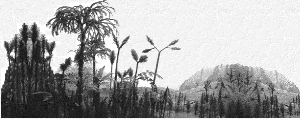

 |
|
 |

|
Rhynie in the Grampian Region of Scotland has become famous as one of the most important palaeobotanical localities in the world. In 1912 the Scottish geologist William Mackie discovered an occurrence of Lower Devonian plant-bearing cherts near this small village. Recent radiometric datings of these rocks give an age of 396 ± 12 million years (Pragian) which is well in accordance with palynological datings of intercalated shale horizons. Mackie published a short note on the outcrop, a few trenches were dug and additional material was collected for further research. The fossil plant remains were studied by the palaeobotanists Robert Kidston and William H. Lang. Their results were published in a series of five papers which appeared between 1917 and 1921. These contributions are now generally regarded as among the most influential papers on fossil plants that have ever been published. Kidston and Lang gave the first descriptions of these oldest known anatomically preserved vascular land plants. Most species appeared to belong to a group that is completely extinct. In addition, they described a number of lower plants. The preservation of the plant material and the associated early terrestrial animals remains is often superb. The large diversity of life forms, varying from unicellular organisms to vascular land plants and terrestrial arthropods as well as their exquisite preservation and the fact that these fossils often occur in life position, make Rhynie a unique locality. Although the Rhynie Chert has been studied for nearly a century, exciting finds are still being made. On the other hand many questions still need to answered. Several institutes take part in Rhynie Chert research, e.g., Aberdeen (geology, depositional environments, geochemistry, palaeontology), Münster (palaeobotany), Cardiff (palaeobotany, silicification processes), Manchester (arthropods), Sheffield (palynology). In Münster Rhynie Chert research started in the mid-1970s and is still continued today. Our collection includes ca. 5000 thin sections and is probably the world's largest collection of Rhynie Chert slides. |
| Unfortunately the local outcrop conditions are extremely poor. Most material was collected from loose pieces of rock and from a few temporary trenches. Visitors to the site will only find a green meadow. The extension and thickness of the chert beds remained largely unknown until in 1997 a series of nine research boreholes was drilled, the deepest one reaching down to 234 m deep. Detailed investigations on the geology, deposition and geochemistry of these cherts as well as on the fauna are currently being carried out by our colleagues from the Department of Geology and Petroleum Geology of the University of Aberdeen. The occurrence of the cherts is related to volcanic activity and they been formed as hot spring deposits. Several different types of chert can be recognised, varying from vuggy, sinter-like cherts, often with upright standing plant axes to more massive chert types formed during flooding events with silica-rich waters. Similar deposits are nowadays being formed in hot springs, e.g., in Yellowstone National Park (California, USA) and in Rotarua (North Island, New Zealand). Plants are known in various modes of preservation, ranging from truly excellent to already largely being decayed. The silicification process must have occurred very quickly, within a few days or even much less, because even very delicate plant structures and also very short-lived life and developmental stages have been preserved, like germinating spores, freshly released sperm cells and developing arbuscles of vesicular arbuscular mycorrhiza. The higher land plants do not only show many details of their anatomy but also their ontogenetic development. In several cases whole life cycles can be studied. Some of these life cycles are now even better known that those of many extant plants. The specimen on the right shows a piece of chert with many axes of the early land plant Aglaophyton major, the roundish ones below are ca. 3 mm in diameter. | 
|
| © Forschungsstelle für Paläobotanik, Westfälische Wilhelms-Universität Münster |
April 2000
|